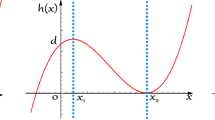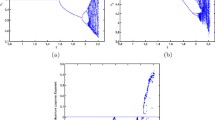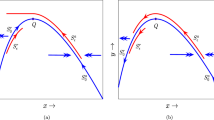Abstract
In this paper, we systematical study the rich dynamics and complex bifurcations of a non-monotonic predator–prey system with a constant releasing rate for the predator. We prove that the system can have at most three positive equilibria, and can undergo a sequence of bifurcations, including transcritical, saddle-node, Hopf, degenerate Hopf, double limit cycle, saddle-node homoclinic bifurcation (or homoclinic loop with a saddle-node), cusp bifurcation of codimension 2, and Bogdanov–Takens bifurcation of codimension 2 and 3. And the system can generate very rich dynamics, such as the existence of a semi-stable limit cycle, multiple coexistent periodic orbits, homoclinic loops, etc. Moreover, our results show that the dynamical behaviors highly rely on the constant releasing rate of predators and the initial conditions. That is, there exists a critical value of the constant releasing rate of predators such that (i) when the constant releasing rate is greater than the critical value, the prey goes to extinction for all admissible initial populations of both species; (ii) when the constant releasing rate is less than the critical value, the prey can always coexist with the predator. Numerical simulations are presented to verify the main results.









Similar content being viewed by others
Data Availability
Data sharing not applicable to this article as no data-sets were generated or analysed during the current study.
References
Huang, J., Ruan, S., Song, J.: Bifurcations in a predator-prey system of Leslie type with generalized Holling type III functional response. J. Differ. Equ. 257(6), 1721–1752 (2014)
Li, C., Zhu, H.: Canard cycles for predator-prey systems with Holling types of functional response. J. Differ. Equ. 254, 879–910 (2013)
Ruan, S., Xiao, D.: Global analysis in a predator-prey system with nonmonotonic funcational response. SIAM J. Appl. Math. 61(4), 1445–1472 (2001)
Xiao, D., Zhu, H.: Multiple focus and Hopf bifurcations in a predator-prey system with nonmonotonic functional response. SIAM J. Appl. Math. 66(3), 802–819 (2006)
Zhu, H., Campbell, S.A., Wolkowicz, G.S.K.: Bifurcation analysis of a predator-prey system with nonmonotonic functional response. SIAM J. Appl. Math. 63(2), 636–682 (2002)
Freedman, H.I., Wolkowicz, G.S.: Predator-prey systems with group defence: the paradox of enrichment revisited. Bull. Math. Biol. 48(5–6), 493 (1986)
Watson, A., Tener, J.S.: Muskoxen in Canada: a biological and taxonomic review. J. Appl. Ecol. 4(1), 257 (1965)
Holmes, J.C., Bethel, W.M.: Modification of intermediate host behaviour by parasites. Zool. J. Linn. Soc. 51(Supplement 1), 123–149 (1972)
Lenteren, V.J.C.: Integrated pest management in protected crops. Integr. Pest. Manag. D 17(3), 270–275 (1987)
Tang, S., Cheke, R.A.: State-dependent impulsive models of integrated pest management (IPM) strategies and their dynamic consequences. J. Math. Biol. 50, 257–292 (2005)
Zhu, H., Ding, Q., Wang, F., Wang, H.: Dynamics on tumor immunotherapy model with periodic impulsive infusion. Int. J. Biomath. 9(5), 261 (2016)
Qin, W., Tan, X., Tosato, M., Liu, X.: Threshold control strategy for a non-smooth Filippov ecosystem with group defense. Appl. Math. Comput. 362, 1–18 (2019)
Wang, A., Xiao, Y., Zhu, H.: Dynamics of a Filippov epidemic model with limited hospital beds. Math. Biosci. Eng. 15(3), 739–764 (2018)
Zhou, H., Wang, X., Tang, S.: Global dynamics of non-smooth Filippov pest-natural enemy system with constant releasing rate. Math. Biosci. Eng. 16(6), 7327–7361 (2019)
Kuznetsov, Y.A., Rinalai, S., Gragnani, A.: One-parameter bifurcations in planar Filippov systems. Int. J. Bifurc. Chaos. 13(8), 2157–2188 (2003)
Tang, S., Pang, W., Cheke, R.A., Wu, J.: Global dynamics of a state-dependent feedback control system. Adv. Differ. Equ. N. Y. 322, 1–70 (2015)
Kirschner, D., Panetta, J.C.: Modeling immunotherapy of the tumor-immune interaction. J. Math. Biol. 37(3), 235–252 (1998)
Eftimie, R., Bramson, J.L., Earn, D.J.D.: Interactions between the immune system and cancer: a brief review of non-spatial mathematical models. Bull. Math. Biol. 73(1), 2–32 (2011)
Li, C., Li, J., Ma, Z.: Codimension 3 B-T bifurcation in an epidemic model with nonlinear incidence. Discrete Contin. Dyn. Syst. Ser. B 20(4), 1107–1116 (2015)
Shan, C., Zhu, H.: Bifurcations and complex dynamics of an SIR model with the impact of the number of hospital beds. J. Differ. Equ. 257(5), 1662–1688 (2014)
Kuznetsov, Y.A.: Elements of Applied Bifurcation Theory, 2nd edn. Springer, New York (1998)
Chow, S.N., Li, C., Wang, D.: Normal Forms and Bifurcation of Planar Vector Fields. Cambridge University Press, Cambridge (1994)
Chen, L., Jing, Z.: The existence and uniqueness of the limit cycle of the differential equations in the predator-prey system. Chin. Sci. Bull. 9, 521–523 (1982)
Perko, L.: Differential Equations and Dynamical Systems, 3rd edn. Springer, New York (2001)
Zhang, Z., Ding, T., Huang, W., Dong, Z.: Qualitative Theory of Differential Equations. Science Press, Beijing (1992)
Lamontagne, Y., Coutu, C., Rousseau, C.: Bifurcation analysis of a predator-prey system with generalised Holling type III functional response. J. Dyn. Differ. Equ. 20(3), 535–571 (2008)
Xiang, C., Huang, J., Ruan, S., Xiao, D.: Bifurcation analysis in a host-generalist parasitoid model with Holling II functional response. J. Differ. Equ. 268(8), 4618–4662 (2019)
Mei, Z.: Liapunov-Schmidt Method. Numerical Bifurcation Analysis for Reaction-Diffusion Equations. Springer, Berlin (2000)
Huang, J., Liu, S., Ruan, S., Zhang, X.: Bogdanov-Takens bifurcation of codimension 3 in a predator-prey model with constant-yield predator harvesting. Commun. Pure Appl. Anal. 15(2), 1053–1067 (2016)
Dumortier, F., Roussarie, R., Sotomayor, J.: Generic 3-parameter families of vector fields on the plane, unfolding a singularity with nilpotent linear part. The cusp case of codimension 3. Ergod. Theory Dyn. Syst. 7(3), 375–413 (1987)
Cai, L., Chen, G., Xiao, D.: Multiparametric bifurcations of an epidemiological model with strong Allee effect. J. Math. Biol. 67(2), 185–215 (2013)
Dumortier, F., Roussarie, R., Sotomayor, S., Zoladek, H.: Bifurcations of Planar Vector Fields Nilpotent Singularities and Abelian Integrals. Lecture Notes in Mathematics. Springer, Berlin (1991)
Acknowledgements
This work was supported by the National Natural Science Foundation of China (Grant No. 12031010 and No. 61772017), the Fundamental Research Funds for the Central Universities (Grant No. 2021CBLY002).
Author information
Authors and Affiliations
Corresponding author
Additional information
Publisher's Note
Springer Nature remains neutral with regard to jurisdictional claims in published maps and institutional affiliations.
Appendices
Appendix A: Proof of Lemma 3.1
Proof
Considering the function
It follows from \(H(x_{1})=0\) that \(x_{1}\) is a positive real root of the cubic equation \(H(x)=0\). Moreover, since H(x) passes the point (0, c), and \(H(+\infty )=+\infty \) and \(H(-\infty )=-\infty \), the cubic equation \(H(x)=0\) always has a negative real root. Hence, the cubic equation \(H(x)=0\) has three real roots (a negative real root and two positive real roots), as shown in Fig. 10. Denote the roots of the cubic equation \(H(x)=0\) as follows:
where \(x_{1}\) is equal to one of \(x_{02}\) and \(x_{03}\). Especially, when \(H'(x)|_{x=x_{1}}=0\), we have
where \(\Delta _{*}=(2a-ac)^{2}+9a(b-1)>0\). Thus, we have \(H'(x_{1})= 0\) if and only if \(x_{1}=\frac{(2a-ac)+\sqrt{\Delta _{*}}}{9a}\). The proof is completed. \(\square \)
Appendix B: Coefficients in the proof of Theorem 3.4
Here we provide the expressions of some coefficients that were used in the proof of Theorem 3.4.
-
\(m_{11}= \frac{(1-x^{*}_{1})(x^{*}_{1})^{2}}{1+a_{0}(x^{*}_{1})^{2}}\), \(m_{12}=(x^{*}_{1}-1)x^{*}_{1}\), \(m_{13}=\frac{x^{*}_{1}}{1+a_{0}(x^{*}_{1})^{2}}\),
-
\(m_{21}=\frac{[12(x^{*}_{1})^{2}-15x^{*}_{1}+4][7(x^{*}_{1})^{2}-8x^{*}_{1}+2][-24(x^{*}_{1})^{3}+33(x^{*}_{1})^{2}-15x^{*}_{1}+2]}{2(x^{*}-1)(5x^{*}_{1}-2)[6(x^{*}_{1})^{2}-6x^{*}_{1}+1](3x^{*}_{1}-1)^{2}}\),
-
\(m_{22}=\frac{[7(x^{*}_{1})^{2}-8x^{*}_{1}+2][24(x^{*}_{1})^{3}-33(x^{*}_{1})^{2}+15x^{*}_{1}-2]}{x^{*}_{1}[6(x^{*}_{1})^{2}-6x^{*}_{1}+1](3x^{*}_{1}-1)^{2}}\),
-
\(m_{23}=\frac{(2x^{*}_{1}-1)[12(x^{*}_{1})^{2}-15x^{*}_{1}+4][57(x^{*}_{1})^{3}-81 (x^{*}_{1})^{2}+33x^{*}_{1}-4]}{x^{*}_{1}(x^{*}_{1}-1)(5x^{*}_{1}-2)[6(x^{*}_{1})^{2}-6x^{*}_{1}+1](3x^{*}_{1}-1)^{2}}\),
-
\(m_{31}=\frac{[12 (x^{*}_{1})^{2}-15 x^{*}_{1}+4] [-15060(x^{*}_{1})^{10}+72837(x^{*}_{1})^{9}-154485(x^{*}_{1})^{8}+189370 (x^{*}_{1})^{7}-148793(x^{*}_{1})^{6}+78459(x^{*}_{1})^{5}-28182(x^{*}_{1})^{4}+6825(x^{*}_{1})^{3} -1069(x^{*}_{1})^{2}+98x^{*}_{1} -4]}{2(3x^{*}_{1}-1)^{3}(5x^{*}_{1}-2)^{2}(x^{*}_{1}-1)^{2}[6(x^{*}_{1})^{2}-6x^{*}_{1}+1]^{2}x^{*}_{1}}\),
-
\(m_{32}=\frac{-6108(x^{*}_{1})^{10}+32877(x^{*}_{1})^{9}-78921 (x^{*}_{1})^{8}+110363 (x^{*}_{1})^{7}-98839(x^{*}_{1})^{6}+58890(x^{*}_{1})^{5}-23540(x^{*}_{1})^{4}+6215(x^{*}_{1})^{3} -1035(x^{*}_{1})^{2}+98x^{*}_{1} -4}{(3x^{*}_{1}-1)^{3}(5x^{*}_{1}-2)(x^{*}_{1}-1)[6(x^{*}_{1})^{2}-6x^{*}_{1}+1]^{2}(x^{*}_{1})^{2}}\),
-
\(m_{33}= \frac{(1-2x^{*}_{2})[57(x^{*}_{1})^{3}-81(x^{*}_{1})^{2}+33 x^{*}_{1}-4][12 (x^{*}_{1})^{2}-15 x^{*}_{1}+4][73(x^{*}_{1})^{5}-180(x^{*}_{1})^{4}+166(x^{*}_{1})^{3}-71(x^{*}_{1})^{2}+14x^{*}_{1}-1]}{2(3x^{*}_{1}-1)^{3}(5x^{*}_{1}-2)^{2}(x^{*}_{1}-1)^{2}[6(x^{*}_{1})^{2}-6x^{*}_{1}+1]^{2}(x^{*}_{1})^{2}}\).
Rights and permissions
About this article
Cite this article
Zhou, H., Tang, B., Zhu, H. et al. Bifurcation and Dynamic Analyses of Non-monotonic Predator–Prey System with Constant Releasing Rate of Predators. Qual. Theory Dyn. Syst. 21, 10 (2022). https://doi.org/10.1007/s12346-021-00539-w
Received:
Accepted:
Published:
DOI: https://doi.org/10.1007/s12346-021-00539-w
Keywords
- Non-monotonic predator–prey system
- Constant releasing rate
- Hopf bifurcation
- Saddle-node homoclinic bifurcation
- Cusp bifurcation
- Bogdanov–Takens bifurcation





